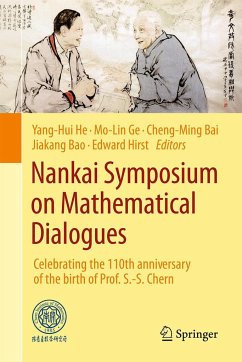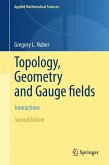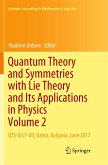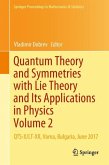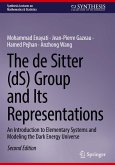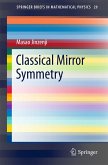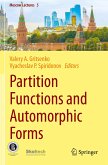Nankai Symposium on Mathematical Dialogues
Celebrating the 110th Anniversary of the Birth of Prof. S.-S. Chern
Herausgegeben:He, Yang-Hui; Ge, Mo-Lin; Bai, Cheng-Ming; Bao, Jiakang; Hirst, Edward
Nankai Symposium on Mathematical Dialogues
Celebrating the 110th Anniversary of the Birth of Prof. S.-S. Chern
Herausgegeben:He, Yang-Hui; Ge, Mo-Lin; Bai, Cheng-Ming; Bao, Jiakang; Hirst, Edward
- Gebundenes Buch
- Merkliste
- Auf die Merkliste
- Bewerten Bewerten
- Teilen
- Produkt teilen
- Produkterinnerung
- Produkterinnerung
This volume is the proceedings of a special conference dedicated to the legacy of Prof. S.-S. Chern, virtually held at the Chern Institute of Mathematics, Nankai University. The conference lasted 2 weeks, and included more than 80 talks, highlighted by a special public lecture by Sir Roger Penrose, on his Nobel winning work on black-holes.
The talks ranged from string theory to number theory, from algebraic geometry to muon detectors, from machine-learning to category theory, etc., all intended to be colloquium-style talks lasting 45 min each. Prof. Chern was a huge proponent and…mehr
Andere Kunden interessierten sich auch für
![Topology, Geometry and Gauge fields Topology, Geometry and Gauge fields]() Gregory L. NaberTopology, Geometry and Gauge fields65,99 €
Gregory L. NaberTopology, Geometry and Gauge fields65,99 €![The Versatile Soliton The Versatile Soliton]() Alexandre T. FilippovThe Versatile Soliton38,99 €
Alexandre T. FilippovThe Versatile Soliton38,99 €![Quantum Theory and Symmetries with Lie Theory and Its Applications in Physics Volume 2 Quantum Theory and Symmetries with Lie Theory and Its Applications in Physics Volume 2]() Quantum Theory and Symmetries with Lie Theory and Its Applications in Physics Volume 2136,99 €
Quantum Theory and Symmetries with Lie Theory and Its Applications in Physics Volume 2136,99 €![Quantum Theory and Symmetries with Lie Theory and Its Applications in Physics Volume 2 Quantum Theory and Symmetries with Lie Theory and Its Applications in Physics Volume 2]() Quantum Theory and Symmetries with Lie Theory and Its Applications in Physics Volume 2136,99 €
Quantum Theory and Symmetries with Lie Theory and Its Applications in Physics Volume 2136,99 €![The de Sitter (dS) Group and Its Representations The de Sitter (dS) Group and Its Representations]() Mohammad EnayatiThe de Sitter (dS) Group and Its Representations31,99 €
Mohammad EnayatiThe de Sitter (dS) Group and Its Representations31,99 €![Classical Mirror Symmetry Classical Mirror Symmetry]() Masao JinzenjiClassical Mirror Symmetry53,99 €
Masao JinzenjiClassical Mirror Symmetry53,99 €![Partition Functions and Automorphic Forms Partition Functions and Automorphic Forms]() Partition Functions and Automorphic Forms46,99 €
Partition Functions and Automorphic Forms46,99 €-
-
-
This volume is the proceedings of a special conference dedicated to the legacy of Prof. S.-S. Chern, virtually held at the Chern Institute of Mathematics, Nankai University. The conference lasted 2 weeks, and included more than 80 talks, highlighted by a special public lecture by Sir Roger Penrose, on his Nobel winning work on black-holes.
The talks ranged from string theory to number theory, from algebraic geometry to muon detectors, from machine-learning to category theory, etc., all intended to be colloquium-style talks lasting 45 min each. Prof. Chern was a huge proponent and influential figure in Mathematical Dialogues and the wide range of topics and discussions are in this spirit.
This book is appealing to mathematicians at the PhD level who are eager to learn about how interesting mathematics show up in different fields, especially geometry, theoretical physics, number theory and modern data science.
Chapter 9 is licensed under the terms of the Creative Commons Attribution-NonCommercial-NoDerivatives 4.0 International License. For further details see license information in the chapter.
The talks ranged from string theory to number theory, from algebraic geometry to muon detectors, from machine-learning to category theory, etc., all intended to be colloquium-style talks lasting 45 min each. Prof. Chern was a huge proponent and influential figure in Mathematical Dialogues and the wide range of topics and discussions are in this spirit.
This book is appealing to mathematicians at the PhD level who are eager to learn about how interesting mathematics show up in different fields, especially geometry, theoretical physics, number theory and modern data science.
Chapter 9 is licensed under the terms of the Creative Commons Attribution-NonCommercial-NoDerivatives 4.0 International License. For further details see license information in the chapter.
Produktdetails
- Produktdetails
- Verlag: Springer / Springer Nature Singapore / Springer, Berlin
- Artikelnr. des Verlages: 978-981-19-2327-2
- 2024 edition
- Seitenzahl: 300
- Erscheinungstermin: 21. September 2025
- Englisch
- Abmessung: 235mm x 155mm
- ISBN-13: 9789811923272
- ISBN-10: 9811923272
- Artikelnr.: 63611664
- Herstellerkennzeichnung
- Libri GmbH
- Europaallee 1
- 36244 Bad Hersfeld
- gpsr@libri.de
- Verlag: Springer / Springer Nature Singapore / Springer, Berlin
- Artikelnr. des Verlages: 978-981-19-2327-2
- 2024 edition
- Seitenzahl: 300
- Erscheinungstermin: 21. September 2025
- Englisch
- Abmessung: 235mm x 155mm
- ISBN-13: 9789811923272
- ISBN-10: 9811923272
- Artikelnr.: 63611664
- Herstellerkennzeichnung
- Libri GmbH
- Europaallee 1
- 36244 Bad Hersfeld
- gpsr@libri.de
Professor Yang-Hui He is a Fellow of the London Institute for Mathematical Sciences, housed in the Michael Faraday suites in the Royal Institute of Great Britain; professor of mathematics at City, University of London; Tutor in mathematics at Merton College, University of Oxford; and Chang-Jiang Chair of physics at Nankai University. He works at the interface of string theory, algebraic and combinatorial geometry, and was one of the pioneers in introducing machine learning to theoretical physics and pure mathematics. Professor Mo-Lin Ge is a professor at the Chern Institute of Mathematics, Nankai University, China. He is also an Academician of Chinese Academy of Science. He has a long and distinguished career in the field of theoretical physics since the 1960s and has made many contributions to mathematical physics. Professor Chengming Bai is a professor and current director at the Chern Institute of Mathematics, Nankai University, China. He has been interested in the study of certain algebraic systems which are related to mathematical physics and Lie theory, and their applications. Jiakang Bao is a PhD student at City, University of London under the supervision of Prof. Y.-H. He, and a visiting researcher at the London Institute for Mathematical Sciences. His current research interests lie primarily in quiver gauge theories and BPS algebras, in the interface between theoretical physics, algebraic geometry and number theory. Edward Hirst is a Doctoral researcher at City, University of London with Professor Y.-H He and a visiting researcher at the London Institute for Mathematical Sciences. He examines mathematical objects within theoretical physics, focusing on those related to string and gauge theories as well as the related algebraic geometry, in particular Calabi-Yau manifolds. His current work centres on applications of a variety of techniques from machine learning to databases ofthese objects, with the aim of uncovering interesting phenomena and interrelations. He will start his postdoctoral fellowship at Queen Mary, University of London.
1. Space
Time Singularities and Cyclic Geometry: Public Lecture. Commemorating Professor S.
S. Chern’s 110th by Roger Penrose (video + an introduction by Yang
Hui He).
2. Vanishing Yukawa Couplings and the Geometry of String Theory Models by Lara Anderson, James Gray, Magdalena Larfors, Matthew Magill.
3. Calabi
Yau Genus
One Fibrations and Twisted Dimensional Reductions of F
theory by Lara Anderson, James Gray, Paul
Konstantin Oehlmann.
4. Calabi
Yau metrics, CFTs and random matrices by Anthony Ashmore.
5. Why Do We Care about Mahler Measure in Physics? By Jiakang Bao.
6. Mirror Symmetry, Born Geometry and String Theory by Per Berglund, Tristan Hübsch, Djordje Minic.
7. Double copying Exceptional Field theories by David Berman, Kwangeon Kim, Kanghoon Lee.
8
.Affine Grassmannians and Brane Systems by Antoine Bourget.
9. Two Applications of Lie Alagebras In Characteristic p > 0 by Lukas Brantner.
10. Recent Developments in Line Bundle Cohomology and Applications to String Phenomenology by Callum Brodie, Andrei Constantin, James Gray, Andre Lukas, Fabian Ruehle.
11. Computation and Data in the Classification of Fano Varieties by Gavin Brown, Tom Coates, Alessio Corti, Tom Ducat, Liana Heuberger, Alexander Kasprzyk.
12. Quantum cluster varieties, scattering diagrams, and the deformed Poisson families by Man
Wai Mandy Cheung.
13. (K)not machine learning by Jessica Craven, Mark Hughes, Vishnu Jejjala, Arjun Kar.
14. Holographic State Complexity from Group Cohomology by Bartlomiej Czech.
15. Duality in Hyperk¨ahler geometry by Andrew Dancer.
16. A sheep in wolf ’s clothing: from group theory to a novel antiviral strategy by Pierre
Philippe Dechant.
17. 2d Supersymmetric Gauge Theories, D
branes and Trialities by Sebasti´an Franco.
18. On a matrix element representation of special functions associated with toric varieties by Anton Gerasimov, Dmitry Lebedev, Sergey Oblezin.
19. Univalent Foundations by Daniel Grayson.
20. Applications of numerically solving polynomial systems by Jonathan Hauenstein.
21. Machine Learning for Hilbert Series by Edward Hirst.
22. Penrose Limit: A Stringy Regime in Holography by Min
xin Huang.
23. Identifying equivalent Calabi–Yau topologies: A discrete challenge from math and physics for machine learning by Vishnu Jejjala, Washington Taylor, Andrew Turner.
24. Mechanical methods in arithmetic geometry? By Minhyong Kim.
25. Progress on BPS spectra of 5d/6d N = 1 supersymmetric field theories by Sung
Soo Kim.
26. Machine Learning Symmetry Shailesh Lal.
27. Kac–Moody Eisenstein series by Kyu
Hwan Lee.
28. On Towers of Light States at Infinite Distance by Seung
Joo Lee.
29. Cubic Action in Double Field Theory by Chen
Te Ma.
30. Two kind of dark energy models for current cosmology tensions: Finslerian and back
reaction effect forms by Xin
He Meng.
31. Confined Vortex Surfaces and Turbulent Statistics by Alexander Migdal.
32. From Chern
Tenenblat to Jackiw
Teitelboim via sine
Gordon by Jeff Murugan.
33. Quantum Matter from Algebraic Geometry and Number Theory by Steven Rayan.
34. Excursions inside black holes and finite temperature CFT’s by Diego Rodriguez
Gomez.
35. Symmetry: from physics and Calabi
Yau threefolds to algebra and Gorenstein rings by Hal Schenck.
36. The global effects of local graph structure by Alexander Scott.
37. Decomposition of quantum field theories by Eric Sharpe.
38. Accessible information: from coins to quantum gravity by Joan Simón.
39. The Structure of K
theoretic Blowup Equations by Kaiwen Sun.
40. Boundary N = 2 Theory, Floer Homologies, Affine Algebras, and the Verlinde Formula by Meng
Chwan Tan.
41. Inverse algorithm and triple point diagrams by Valdo Tatitscheff.
42. Connections between reflected entropies and hyperbolic string vertices by Haitang Yang.
Time Singularities and Cyclic Geometry: Public Lecture. Commemorating Professor S.
S. Chern’s 110th by Roger Penrose (video + an introduction by Yang
Hui He).
2. Vanishing Yukawa Couplings and the Geometry of String Theory Models by Lara Anderson, James Gray, Magdalena Larfors, Matthew Magill.
3. Calabi
Yau Genus
One Fibrations and Twisted Dimensional Reductions of F
theory by Lara Anderson, James Gray, Paul
Konstantin Oehlmann.
4. Calabi
Yau metrics, CFTs and random matrices by Anthony Ashmore.
5. Why Do We Care about Mahler Measure in Physics? By Jiakang Bao.
6. Mirror Symmetry, Born Geometry and String Theory by Per Berglund, Tristan Hübsch, Djordje Minic.
7. Double copying Exceptional Field theories by David Berman, Kwangeon Kim, Kanghoon Lee.
8
.Affine Grassmannians and Brane Systems by Antoine Bourget.
9. Two Applications of Lie Alagebras In Characteristic p > 0 by Lukas Brantner.
10. Recent Developments in Line Bundle Cohomology and Applications to String Phenomenology by Callum Brodie, Andrei Constantin, James Gray, Andre Lukas, Fabian Ruehle.
11. Computation and Data in the Classification of Fano Varieties by Gavin Brown, Tom Coates, Alessio Corti, Tom Ducat, Liana Heuberger, Alexander Kasprzyk.
12. Quantum cluster varieties, scattering diagrams, and the deformed Poisson families by Man
Wai Mandy Cheung.
13. (K)not machine learning by Jessica Craven, Mark Hughes, Vishnu Jejjala, Arjun Kar.
14. Holographic State Complexity from Group Cohomology by Bartlomiej Czech.
15. Duality in Hyperk¨ahler geometry by Andrew Dancer.
16. A sheep in wolf ’s clothing: from group theory to a novel antiviral strategy by Pierre
Philippe Dechant.
17. 2d Supersymmetric Gauge Theories, D
branes and Trialities by Sebasti´an Franco.
18. On a matrix element representation of special functions associated with toric varieties by Anton Gerasimov, Dmitry Lebedev, Sergey Oblezin.
19. Univalent Foundations by Daniel Grayson.
20. Applications of numerically solving polynomial systems by Jonathan Hauenstein.
21. Machine Learning for Hilbert Series by Edward Hirst.
22. Penrose Limit: A Stringy Regime in Holography by Min
xin Huang.
23. Identifying equivalent Calabi–Yau topologies: A discrete challenge from math and physics for machine learning by Vishnu Jejjala, Washington Taylor, Andrew Turner.
24. Mechanical methods in arithmetic geometry? By Minhyong Kim.
25. Progress on BPS spectra of 5d/6d N = 1 supersymmetric field theories by Sung
Soo Kim.
26. Machine Learning Symmetry Shailesh Lal.
27. Kac–Moody Eisenstein series by Kyu
Hwan Lee.
28. On Towers of Light States at Infinite Distance by Seung
Joo Lee.
29. Cubic Action in Double Field Theory by Chen
Te Ma.
30. Two kind of dark energy models for current cosmology tensions: Finslerian and back
reaction effect forms by Xin
He Meng.
31. Confined Vortex Surfaces and Turbulent Statistics by Alexander Migdal.
32. From Chern
Tenenblat to Jackiw
Teitelboim via sine
Gordon by Jeff Murugan.
33. Quantum Matter from Algebraic Geometry and Number Theory by Steven Rayan.
34. Excursions inside black holes and finite temperature CFT’s by Diego Rodriguez
Gomez.
35. Symmetry: from physics and Calabi
Yau threefolds to algebra and Gorenstein rings by Hal Schenck.
36. The global effects of local graph structure by Alexander Scott.
37. Decomposition of quantum field theories by Eric Sharpe.
38. Accessible information: from coins to quantum gravity by Joan Simón.
39. The Structure of K
theoretic Blowup Equations by Kaiwen Sun.
40. Boundary N = 2 Theory, Floer Homologies, Affine Algebras, and the Verlinde Formula by Meng
Chwan Tan.
41. Inverse algorithm and triple point diagrams by Valdo Tatitscheff.
42. Connections between reflected entropies and hyperbolic string vertices by Haitang Yang.
1. Space
Time Singularities and Cyclic Geometry: Public Lecture. Commemorating Professor S.
S. Chern’s 110th by Roger Penrose (video + an introduction by Yang
Hui He).
2. Vanishing Yukawa Couplings and the Geometry of String Theory Models by Lara Anderson, James Gray, Magdalena Larfors, Matthew Magill.
3. Calabi
Yau Genus
One Fibrations and Twisted Dimensional Reductions of F
theory by Lara Anderson, James Gray, Paul
Konstantin Oehlmann.
4. Calabi
Yau metrics, CFTs and random matrices by Anthony Ashmore.
5. Why Do We Care about Mahler Measure in Physics? By Jiakang Bao.
6. Mirror Symmetry, Born Geometry and String Theory by Per Berglund, Tristan Hübsch, Djordje Minic.
7. Double copying Exceptional Field theories by David Berman, Kwangeon Kim, Kanghoon Lee.
8
.Affine Grassmannians and Brane Systems by Antoine Bourget.
9. Two Applications of Lie Alagebras In Characteristic p > 0 by Lukas Brantner.
10. Recent Developments in Line Bundle Cohomology and Applications to String Phenomenology by Callum Brodie, Andrei Constantin, James Gray, Andre Lukas, Fabian Ruehle.
11. Computation and Data in the Classification of Fano Varieties by Gavin Brown, Tom Coates, Alessio Corti, Tom Ducat, Liana Heuberger, Alexander Kasprzyk.
12. Quantum cluster varieties, scattering diagrams, and the deformed Poisson families by Man
Wai Mandy Cheung.
13. (K)not machine learning by Jessica Craven, Mark Hughes, Vishnu Jejjala, Arjun Kar.
14. Holographic State Complexity from Group Cohomology by Bartlomiej Czech.
15. Duality in Hyperk¨ahler geometry by Andrew Dancer.
16. A sheep in wolf ’s clothing: from group theory to a novel antiviral strategy by Pierre
Philippe Dechant.
17. 2d Supersymmetric Gauge Theories, D
branes and Trialities by Sebasti´an Franco.
18. On a matrix element representation of special functions associated with toric varieties by Anton Gerasimov, Dmitry Lebedev, Sergey Oblezin.
19. Univalent Foundations by Daniel Grayson.
20. Applications of numerically solving polynomial systems by Jonathan Hauenstein.
21. Machine Learning for Hilbert Series by Edward Hirst.
22. Penrose Limit: A Stringy Regime in Holography by Min
xin Huang.
23. Identifying equivalent Calabi–Yau topologies: A discrete challenge from math and physics for machine learning by Vishnu Jejjala, Washington Taylor, Andrew Turner.
24. Mechanical methods in arithmetic geometry? By Minhyong Kim.
25. Progress on BPS spectra of 5d/6d N = 1 supersymmetric field theories by Sung
Soo Kim.
26. Machine Learning Symmetry Shailesh Lal.
27. Kac–Moody Eisenstein series by Kyu
Hwan Lee.
28. On Towers of Light States at Infinite Distance by Seung
Joo Lee.
29. Cubic Action in Double Field Theory by Chen
Te Ma.
30. Two kind of dark energy models for current cosmology tensions: Finslerian and back
reaction effect forms by Xin
He Meng.
31. Confined Vortex Surfaces and Turbulent Statistics by Alexander Migdal.
32. From Chern
Tenenblat to Jackiw
Teitelboim via sine
Gordon by Jeff Murugan.
33. Quantum Matter from Algebraic Geometry and Number Theory by Steven Rayan.
34. Excursions inside black holes and finite temperature CFT’s by Diego Rodriguez
Gomez.
35. Symmetry: from physics and Calabi
Yau threefolds to algebra and Gorenstein rings by Hal Schenck.
36. The global effects of local graph structure by Alexander Scott.
37. Decomposition of quantum field theories by Eric Sharpe.
38. Accessible information: from coins to quantum gravity by Joan Simón.
39. The Structure of K
theoretic Blowup Equations by Kaiwen Sun.
40. Boundary N = 2 Theory, Floer Homologies, Affine Algebras, and the Verlinde Formula by Meng
Chwan Tan.
41. Inverse algorithm and triple point diagrams by Valdo Tatitscheff.
42. Connections between reflected entropies and hyperbolic string vertices by Haitang Yang.
Time Singularities and Cyclic Geometry: Public Lecture. Commemorating Professor S.
S. Chern’s 110th by Roger Penrose (video + an introduction by Yang
Hui He).
2. Vanishing Yukawa Couplings and the Geometry of String Theory Models by Lara Anderson, James Gray, Magdalena Larfors, Matthew Magill.
3. Calabi
Yau Genus
One Fibrations and Twisted Dimensional Reductions of F
theory by Lara Anderson, James Gray, Paul
Konstantin Oehlmann.
4. Calabi
Yau metrics, CFTs and random matrices by Anthony Ashmore.
5. Why Do We Care about Mahler Measure in Physics? By Jiakang Bao.
6. Mirror Symmetry, Born Geometry and String Theory by Per Berglund, Tristan Hübsch, Djordje Minic.
7. Double copying Exceptional Field theories by David Berman, Kwangeon Kim, Kanghoon Lee.
8
.Affine Grassmannians and Brane Systems by Antoine Bourget.
9. Two Applications of Lie Alagebras In Characteristic p > 0 by Lukas Brantner.
10. Recent Developments in Line Bundle Cohomology and Applications to String Phenomenology by Callum Brodie, Andrei Constantin, James Gray, Andre Lukas, Fabian Ruehle.
11. Computation and Data in the Classification of Fano Varieties by Gavin Brown, Tom Coates, Alessio Corti, Tom Ducat, Liana Heuberger, Alexander Kasprzyk.
12. Quantum cluster varieties, scattering diagrams, and the deformed Poisson families by Man
Wai Mandy Cheung.
13. (K)not machine learning by Jessica Craven, Mark Hughes, Vishnu Jejjala, Arjun Kar.
14. Holographic State Complexity from Group Cohomology by Bartlomiej Czech.
15. Duality in Hyperk¨ahler geometry by Andrew Dancer.
16. A sheep in wolf ’s clothing: from group theory to a novel antiviral strategy by Pierre
Philippe Dechant.
17. 2d Supersymmetric Gauge Theories, D
branes and Trialities by Sebasti´an Franco.
18. On a matrix element representation of special functions associated with toric varieties by Anton Gerasimov, Dmitry Lebedev, Sergey Oblezin.
19. Univalent Foundations by Daniel Grayson.
20. Applications of numerically solving polynomial systems by Jonathan Hauenstein.
21. Machine Learning for Hilbert Series by Edward Hirst.
22. Penrose Limit: A Stringy Regime in Holography by Min
xin Huang.
23. Identifying equivalent Calabi–Yau topologies: A discrete challenge from math and physics for machine learning by Vishnu Jejjala, Washington Taylor, Andrew Turner.
24. Mechanical methods in arithmetic geometry? By Minhyong Kim.
25. Progress on BPS spectra of 5d/6d N = 1 supersymmetric field theories by Sung
Soo Kim.
26. Machine Learning Symmetry Shailesh Lal.
27. Kac–Moody Eisenstein series by Kyu
Hwan Lee.
28. On Towers of Light States at Infinite Distance by Seung
Joo Lee.
29. Cubic Action in Double Field Theory by Chen
Te Ma.
30. Two kind of dark energy models for current cosmology tensions: Finslerian and back
reaction effect forms by Xin
He Meng.
31. Confined Vortex Surfaces and Turbulent Statistics by Alexander Migdal.
32. From Chern
Tenenblat to Jackiw
Teitelboim via sine
Gordon by Jeff Murugan.
33. Quantum Matter from Algebraic Geometry and Number Theory by Steven Rayan.
34. Excursions inside black holes and finite temperature CFT’s by Diego Rodriguez
Gomez.
35. Symmetry: from physics and Calabi
Yau threefolds to algebra and Gorenstein rings by Hal Schenck.
36. The global effects of local graph structure by Alexander Scott.
37. Decomposition of quantum field theories by Eric Sharpe.
38. Accessible information: from coins to quantum gravity by Joan Simón.
39. The Structure of K
theoretic Blowup Equations by Kaiwen Sun.
40. Boundary N = 2 Theory, Floer Homologies, Affine Algebras, and the Verlinde Formula by Meng
Chwan Tan.
41. Inverse algorithm and triple point diagrams by Valdo Tatitscheff.
42. Connections between reflected entropies and hyperbolic string vertices by Haitang Yang.

